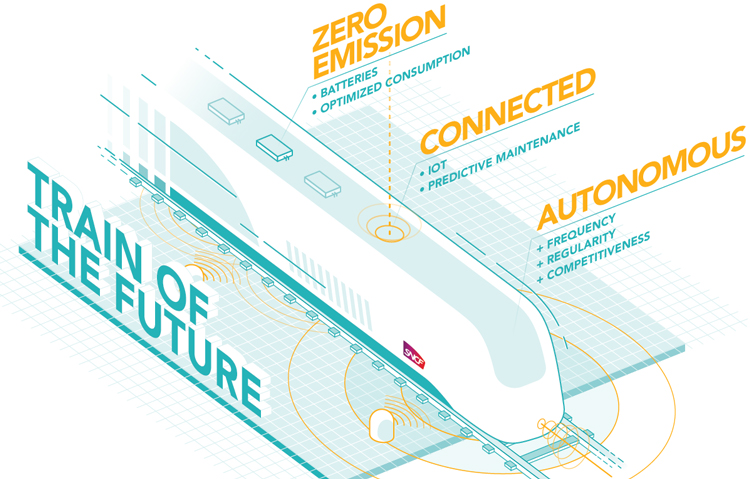SNCF’s train of the future: Connected, driverless and emission-free
Posted: 21 February 2019 | Carole Desnost | No comments yet
The SNCF Group’s mission is to make mobile living easier and enable everyone – passengers, companies, and transport and logistics operators – to take back their time. But how? Carole Desnost, Head of Innovation and Research at SNCF, explains this will be done by delivering shorter distances and travel times, more attractive public transport and a focus on a greener planet…
Today’s mobility industry is experiencing a genuine transformation as markets open up to competition, customer expectations rise, and new players appear in response to changing lifestyles. At the same time, the emergence of digital and other new technologies has created opportunities for rail operators to reinvent themselves and make quantum leaps in competitiveness and performance.
Together new technologies, intelligent automation and new energy storage solutions will change the rail industry, raising expectations on the ground and onboard trains. SNCF will respond with more capacity and greater punctuality, flexibility and energy savings, continuing to provide complete safety as well as better customer service and stronger business performance.
To meet these goals, the train of the future will be connected, driverless and emission-free.
Tomorrow’s connected train
In an increasingly digital world, our trains and ground facilities must be connected spaces, keeping pace with technological change to enhance the customer experience and improve the system’s performance.
With connected trains, maintenance personnel will obtain real-time information on the status of the entire system, from infrastructure to rolling stock to stations, as connected-object technology delivers huge volumes of data on the condition of various components. This information will be fed into predictive models to anticipate the condition of each train at predefined intervals and plan maintenance work efficiently.
Geolocation of trains will also keep the rail system safe by allowing operators to take virtual signalling to its logical conclusion and move away from trackside detectors – a major source of costly maintenance and unavailability. Geolocation is also an essential component of tomorrow’s day-to-day rail operations. It will enable us to replace physical fixed block systems with moving blocks or more sensitive virtual blocks, in addition to operating driverless trains, managing traffic with greater accuracy, and giving customers better information. Fast-changing telecommunications will also support the leap to tomorrow’s connected train, as 5G technology arrives and communication solutions originally designed for road vehicles are applied to rail.
Better service with driverless trains
The rail industry has already seen two great revolutions – electrification and high-speed trains. Driverless operation will be the third. This is primarily a response to saturation on key lines, since it enables better operation of more trains on the same infrastructure, optimising speed, increasing volume, smoothing traffic and improving on-time performance. Driverless trains are also eco-friendly, generating substantial energy savings.
Under its Tech4Rail innovation accelerator programme, SNCF has been working on a driverless train for over two years, laying the groundwork for tomorrow’s rail operations by proving technical, economic and social feasibility. The project has now moved past the emerging stage, with four key components in the experimentation and prototyping stage:
- Obstacle detection
- Signal reading
- Remote driving
- Autonomous TER and freight trains.
We are carrying out these projects in partnership with the French State, through the Technology Research Institute (IRT), and with key industry players. Once the prototype stage is complete, the Group plans to order driverless trains in 2023.


To meet its goals of providing more capacity and greater punctuality, flexibility and energy savings, SNCF’s train of the future will be connected, driverless and emission-free
Saving the planet: Zero-emission trains
SNCF has been working to reduce our carbon footprint for years. Since 1990, the Group has cut per-passenger CO2 by more than 50 per cent and has achieved comparable reductions in emissions per tonne of freight carried.
Today, 80 percent of rail travel (expressed in train kilometres) is powered by electric traction, which translates to a very low CO2 level, thanks to France’s energy mix.
But we are committed to reducing the remaining 20 per cent, and are working on innovative projects to cut energy consumption, eliminate harmful emissions in urban centres and other sensitive areas, and ultimately create a zero-emission train.
From an infrastructure standpoint, the challenge is to achieve ‘frugal electrification’ – a solution that delivers just enough electrical power to power the train, with support from system-based solutions that combine innovations in rolling stock and infrastructure.
From an environmental standpoint, electrifying lines is an efficient solution, but the huge investment means that it cannot be applied system-wide, especially in an era of budget cuts. As a result, we are targeting projects that electrify key portions of line or are especially cost-effective.
In addition, on-board energy storage solutions could deliver a boost during acceleration, enabling us to reduce the need for catenary power without sacrificing performance.
As two major on-board energy storage solutions emerge – batteries and hydrogen – we are taking an innovative approach, developing collaborative projects and getting the full spectrum of players involved. For our hybrid TER project, for example, the Group is already working with several French regions and Alstom, and a hydrogen project is underway.
The hybrid TER, set for in-service testing in France in 2021, will combine diesel and catenary power with energy from onboard lithium-ion batteries. The new train will operate primarily in diesel-plus-battery mode, cutting energy consumption by 20 per cent. Energy stored in the battery can also be used to cut the diesel engine in stations and certain urban areas – an operating mode that reduces emissions to very low levels but limits the train’s range to a few dozen kilometres.
Meanwhile, hydrogen technology is opening new horizons. With a range rivalling that of diesel-powered trains, hybrids that combine hydrogen with electricity or batteries offer the promise of a diesel-free future. We will carry out studies designed to clearly identify the benefits of designs now being considered, with a view to running the first hydrogen-powered train by 2022.
Not science fiction
Thanks to SNCF’s innovation and research projects, our train of the future – connected, driverless and eco-friendly – is coming into focus. We are entering a new era for the rail industry, which will leverage technological progress and new environmental concerns to reinvent itself. And we’re not talking about science fiction, or development that will take 30 years or more. These innovations will be a reality in the next five years – in 2023, or shortly afterwards.


Issue
Related topics
Big Data, Digitalisation, Internet of Things (IoT), Rolling Stock Orders/Developments








